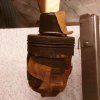sgtlynn
Well-Known Member
Here is a photo of one of the two grenades captured by the Germans from the two Czech Commandos that assasinated Reinhard Heydrich in Czechoslovakia. Currently in the Czech Museum in Prague. Took the photo a couple of weeks ago when I was there.
Talking with Bonnex and he informs me that these modified No. 73 grenades were in fact the ones that led to the development of the No. 82 Gammon Grenade. Very interesting......
Talking with Bonnex and he informs me that these modified No. 73 grenades were in fact the ones that led to the development of the No. 82 Gammon Grenade. Very interesting......






